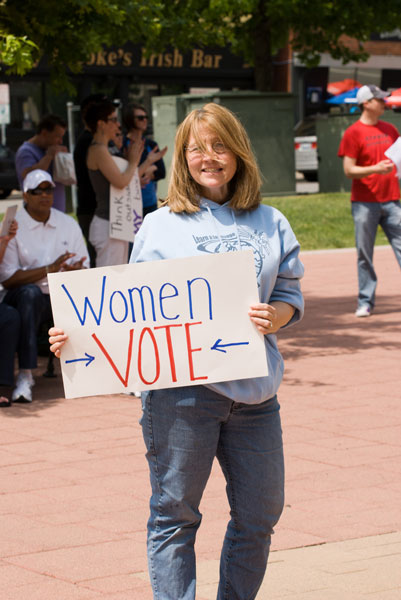By Cannon-Marie Green Milby and Beth Connors-Manke
On April 28, 2012, Kentucky Protest Against the War on Women held a rally in front of the Fayette County Circuit Court.
“We are all aware of the draconian laws being introduced and often passed in many GOP run states,” the group said on its Facebook event page. “Now this war on women has reached our Congress. We represent the majority in this Country and need to make our voices heard.”
The protest was part of a nationwide event sponsored by UniteWomen.org , a grassroots organization created in February 2012 by Karen Teegarden and Desiree Jordan. The mission of Unite Women is to help defend women’s rights and pursuit of equality. The organization takes a two-pronged approach: ‘Main Street USA,’ a public outreach campaign, and ‘Legislative Action,’ a targeted campaign. Local protests on April 28, like the one in Lexington, set their own agendas and picked key issues.
The Kentucky protestors raised the issues of domestic violence, rape, reproductive freedom, and abortion. Demonstrators thrust coat hangers in the air, shouting “we won’t go back,” and carried signs saying “reproductive freedom is a human right,” “keep your Mitt(s) off my birth control,” and “[w]e are the 53%.”
The playbook of the women’s movement is considerably the same as it was in the 1960s. Feminists who stood on the frontlines of the fight for equal rights, equal pay, and reproductive freedom still reference the fear and reasons for the fight in the 1960s. Though the level to which women have won freedoms and protection can be debated, women did get freedoms and protection. Today, however, women are not fighting to gain rights so much as they are fighting to enforce and protect those rights.
Chipping away
No wonder women want to protest. The first half of 2012 has been rife with examples of a volatile political atmosphere trying to chip away at the respect, dignity, and rights of American women. Despite the passage of the Lilly Ledbetter Fair Pay Act in 2009, women still do not earn equal pay for equal work. In February, Virginia tried to pass a law that would require women to submit to a transvaginal ultrasound prior to an abortion. Two months later, Arizona Governor Jan Brewer signed a law protecting the rights of the unborn and legally defining the date of conception, something that medicine doesn’t even do.
The litany goes on. The Violence Against Women Act (VAWA) has yet to be extended, and the Democrats and Republicans continue partisan debates about who to protect under the anti-abuse legislation. Particular focus is on LGBT survivors of violence, immigrant women survivors, and Native American women assaulted on native lands by non-native American men.
And then there was birth control.
Father knows best
2012 kicked off with a 40-day standoff between the Obama Administration, religious leaders, Republicans, and pundits. This confrontation was ignited by the announcement of a final rule requiring that health insurance pay women’s preventative care, including contraception. Under this rule, employer-provided health insurance must include contraceptive coverage, which elicited a request by the Roman Catholic Church for a broad exemption for Catholic-affiliated hospitals, colleges, and charities. The Obama Administration denied this request.
Catholic organizations objected to the rule on the basis that it would deprive them of religious liberty and require them to give up their religious beliefs. Seeking to diffuse the problem and keep health care reform on track for implementation, President Obama added a compromise provision to the rule: religious-affiliated employers can refrain from paying for contraception and instead shift the financial burden to health insurance companies.
A Republican hearing before the House Committee on Oversight and Government Reform was subsequently held on religious freedom and the federal birth control mandate. Five male religious leaders testified that the compromise was unworkable. Mier Soloveichik, rabbi of Yeshiva University and Congregation Kehilath Jeshurun in New York City, told the committee that the compromise “is no accommodation at all. Religious organizations would still be obligated to provide employees with an insurance policy that facilitates acts violating the organization’s religious tenets.” The act facilitated: free contraception for women. When Representative Gerald Connolly (D-VA) called the hearing a sham and a shameful exercise, Representative Joe Walsh (R-IL) countered, insisting that the hearing was not about women or contraceptives. It was about religious freedom.
The argument made at the hearing by the five male representatives of religious groups was that the government is required to protect their religious liberty by forcing women to pay for their own contraception, regardless of its classification as women’s preventative care. Acceptance of this logic would deprive millions of women of access to contraception and effective medical treatment, which is the exact reason the Obama Administration made this rule.
No women testified at this hearing, nor was there a witness to represent the interests of groups and individuals in favor of the mandate.
In response, the House Democratic Steering and Policy Committee held a mock hearing on women’s health and contraception. Still trying to control the issue, the Republican majority leaders had denied the democrats use of the House Recording Studio, barring the hearing from going public, according to Minority Leader Nancy Pelosi (D-CA).
However, the testimony by Georgetown Law Center student Sandra Fluke became the most news-generating part of the mock hearing. Six days after Fluke testified that the federal birth control mandate will meet the critical health care needs of many women, Rush Limbaugh took to the air and called Fluke a “slut” and a “prostitute” during his live radio show.
Calling all women, even the fake ones
Recently, a woman named Julia has taken center-stage at the conservative cabaret. When the Obama campaign introduced Julia, a fictional character, conservatives pounced. “The Life of Julia,” a web slideshow, is presented as a glimpse into “how President Obama’s policies help one woman over her lifetime—and how Mitt Romney would change her story.”
The narrative unfolds this way: Julia enrolls in Head Start. Later, her high school is part of the Race to the Top program, which raises curriculum standards. When Julia goes to college, her family qualifies for the American Opportunity Tax Credit (up to $10,000 over four years), and she receives a Pell Grant. Julia needs surgery in college and is covered because health care reform allows her to stay on her parents’ health insurance until she turns 26.
As she grows up, President Obama’s policies help Julia maintain affordable health insurance and manage her student loan payments. And then, the narrative suggests, prosperity continues: Julia succeeds in her career, and her son attends a public school with better facilities and great teachers. When it comes time to retire, tax-paying Julia receives monthly Social Security benefits and Medicare.
Well, conservatives weren’t persuaded, to say the least. Blogger Michelle Malkin described Julia as representing entitlement, dependency, and redistribution instead of public service, self-sufficiency, and sacrifice. In the National Review Online, conservative writer Carrie Lucas called the “Life of Julia” insulting.
The slideshow is pat and slick and one-dimensional. However, “The Life of Julia” is notable in that it sees Julia’s life beyond the narrow confines of traditional “women’s issues.” Of the 12 scenes in the slideshow, five are about education—her own and her child’s. Three are work related, and four push Obama’s health care reform. Only two are regular features of the women’s rights agenda: free birth control and equal pay. That Julia “benefits from maternal checkups, prenatal care, and free screenings under health care reform” is, in a broad sense, a non-starter. For the most part, we’ve made good health care for pregnant women a cultural value that is already reflected in many health insurance policies.
And, since reproductive freedom and equal pay for equal work are citizens’ issues (if not a human rights issue for both women and men in the case of reproductive freedom), “The Life of Julia” envisions the fictional Julia as a full participant in the trinity of American life: education, work, and family. The slideshow implies that she’s not anyone’s victim because Obama’s policies aren’t about ameliorating damage done to a minority.
Why frame it this way? Because women aren’t a minority.
Pragmatic solidarity
Statistically, women lead the pack in several areas. Census data from 2010 shows that there are more women than men in the U.S. According to the Pew Research Center, a higher percentage of women than men are enrolled in and complete college. And, women represent 53 percent of the vote.
The political question is: do women consider themselves a minority socially—meaning do they believe that cultural attitudes and social practices limit their ability to act in the service of their full human potential?
The prevalence of domestic violence, rape, sex trafficking, and the impulse across many conservative religious communities to silence women’s voices and erase their presence certainly suggests that women have a reason to see themselves as partially marginalized members of our society.
But do these things, these “women’s issues,” encompass all of women’s concerns as citizens?
Well, this election is the time to find out. With 53 percent of the vote, women will get to decide what their issues really are—and our guess is that women’s issues are as diverse as women are. And that they are as broad as Julia’s, who cared about strong and affordable education, quality health care with reasonable costs, a creative and self-motivated work life (she’s a web designer who later starts her own small business), and a retirement during which she can stay active.
Despite the way Obama’s team framed the issues and the conservative response, these concerns aren’t partisan. Nor are they really gendered. Men and women want a good education and strong health care. Men and women want to be able to plan their families and careers. Men and women want their spouses, partners, or lovers to succeed in their work because it enriches (literally and figuratively) their lives.
As it turns out, women may be forced now to do what few have been willing to do in the last three years: think beyond partisanship. Women can organize this election by loosening the ideological girdle that has been constricting our political system and instead choose pragmatic solidarity.
Cannon-Marie Green Milby and Beth Connors-Manke are writing a series about women in the 2012 presidential election. They also write for the blog The Woman Problem in Politics.





Leave a Reply